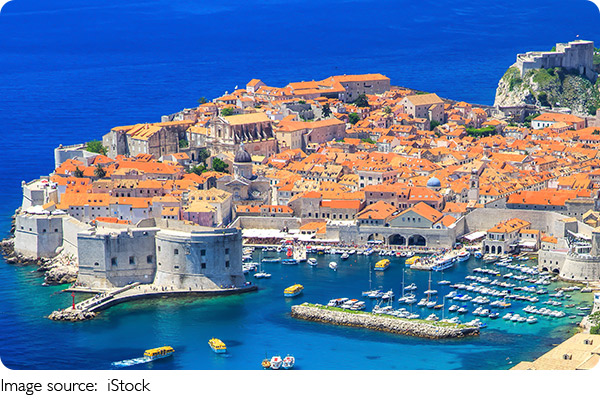Adriatic Duo

Croatia and Montenegro sit along the Adriatic coast, offering breathtaking scenery, history-rich cities, and warm Mediterranean vibes. But when planning a trip, we often wonder: which one suits us better?
Croatia is famous for its medieval towns and islands, while Montenegro is known for dramatic mountains and more affordable travel. To make our choice easier, let’s look at practical details—transportation, entry fees, accommodations, dining, and timing.
Exploring Croatia: What to Expect
Croatia is filled with UNESCO World Heritage sites and coastal gems. Dubrovnik, Split, and Plitvice Lakes are must-sees.
- Dubrovnik Old Town: Entry to the city walls costs around $35 per person. Opening hours vary seasonally, usually 8 AM – 7 PM in summer. Walking the walls takes 2–3 hours.
- Plitvice Lakes National Park: Tickets cost $12–$40 depending on season. Summer (June–September) is the busiest but offers full access to waterfalls and trails. The park is open daily from 7 AM – 8 PM.
- Island Hopping: Ferries to Hvar or Korčula range from $6–$20 one way, with summer schedules running frequently.
- Transportation: Buses between major cities (e.g., Dubrovnik to Split) cost $20–$30, while a one-hour flight is around $80.
- Accommodation: Budget hostels in Dubrovnik start at $25 per night, mid-range hotels are about $80–$120, while luxury resorts can exceed $300 per night.
- Dining: A casual meal costs $12–$15, while a three-course dinner for two in a mid-range restaurant averages $50–$70.
- Best Time to Visit: May–June and September–October for pleasant weather, fewer tourists, and slightly lower prices.
Discovering Montenegro: What to Expect
Montenegro is smaller but offers stunning landscapes, medieval towns, and lower costs compared to Croatia.
- Kotor Old Town: Entry is about $4, open from 8 AM – 8 PM. Climbing up to San Giovanni Fortress costs around $8, with panoramic views of the Bay of Kotor.
- Durmitor National Park: Entrance fee is $3–$4. The park is open year-round, ideal for hiking in summer and skiing in winter.
- Sveti Stefan: The famous islet is partly private, but day access to the beach costs about $20–$25 in peak season.
- Transportation: Buses between Podgorica and Kotor cost $7–$10, while taxis are much cheaper than in Croatia. No trains connect major tourist spots, so buses are the main choice.
- Accommodation: Budget guesthouses like Montenegro Hostel B&B in Kotor start at $15 per night, mid-range hotels cost $50–$80, and luxury stays like Aman Sveti Stefan reach $400+ per night.
- Dining: A casual meal is $8–$10, while a nice dinner for two averages $35–$50. Local seafood is both affordable and fresh.
- Best Time to Visit: Late spring (May–June) and early autumn (September) for warm weather without summer crowds. Winter is great for budget travel, especially for skiing in the north.
Comparing Costs: Croatia vs Montenegro
- Ticket Prices: Croatia’s attractions average $20–$40, while Montenegro’s are usually under $10.
- Transportation: Buses in Montenegro are cheaper, while Croatia offers better ferry and flight connections.
- Accommodation: Montenegro is about 30–40% cheaper than Croatia for the same quality level.
- Dining: Expect to spend about $10–$15 per meal in Croatia, but only $7–$10 in Montenegro.

Time to Decide!
Lykkers, whether we’re drawn to Croatia’s glamorous coastline and bustling historic cities or Montenegro’s tranquil fjords and budget-friendly charm, both destinations promise unforgettable adventures. Croatia is ideal if we love medieval streets, island hopping, and iconic landmarks, while Montenegro offers dramatic mountains, quiet towns, and a more relaxed pace. So, which one sparks our wanderlust today—the polished elegance of Croatia or the wild beauty of Montenegro?
-
 Local AccommodationHow to Discover the Most Authentic Stays During Your Travels
Local AccommodationHow to Discover the Most Authentic Stays During Your Travels -
 Egyptian Flavor BombThis Crispy Egyptian Street Food Will Ruin All Other Sandwiches for You!
Egyptian Flavor BombThis Crispy Egyptian Street Food Will Ruin All Other Sandwiches for You! -
 Shocking World CupWhich Underdog Teams Shocked the World? Let’s Relive the Most Unexpected World Cup Moments That Made History!
Shocking World CupWhich Underdog Teams Shocked the World? Let’s Relive the Most Unexpected World Cup Moments That Made History!